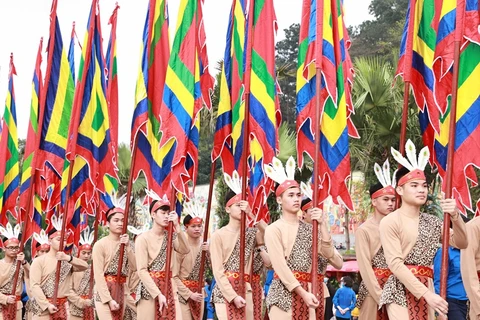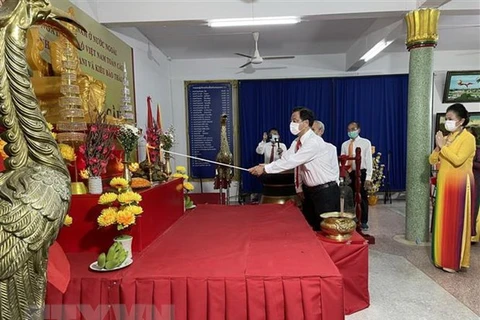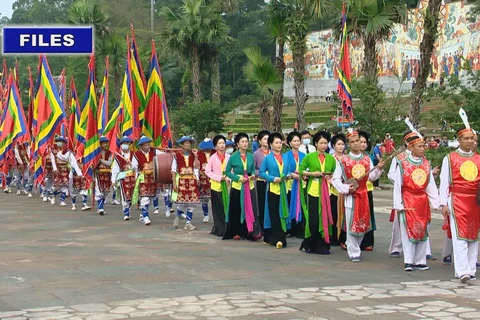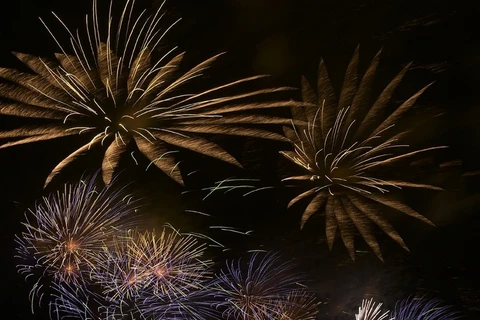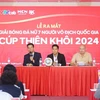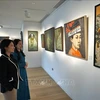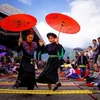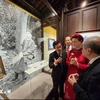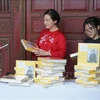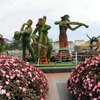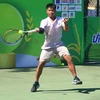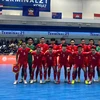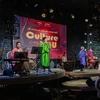 A long-standing tradition is maintained, with soldiers in traditional attire accompanying the palanquin. (Photo: VNA)
A long-standing tradition is maintained, with soldiers in traditional attire accompanying the palanquin. (Photo: VNA) Hanoi (VNA) - Many Vietnamese have in their mind a "six-eight" iambic couplet verse stating that no matter how far Vietnamese people travel, they always remember the Hung Kings’ Commemoration Day. This important holiday falls on the tenth day of the third lunar month in remembrance of the Hung Kings of Vietnam.
On the day, many Vietnamese from all walks of life join a pilgrimage to the ancestor land in Viet Tri city of Phu Tho province.
The Hung Kings’ Commemoration Day is viewed as a celebration of great importance among Vietnamese. It also acts as a symbol of the cultural value, great solidarity, and sense of gratitude and worship of the ancestors of Vietnamese people.
Remembering contributions of Hung Kings
Legend has it that Lac Long Quan (real name Sung Lam, son of Kinh Duong Vuong and Than Long Nu) married Au Co (the fairy daughter of De Lai). Au Co then went on to give birth to a pouch filled with one hundred eggs, which soon hatched into a hundred sons. However, soon thereafter, Lac Long Quan and Au Co separated. Lac Long Quan went to the coast with 50 of the children, while Au Co went to the highlands with the rest.
Their eldest son was made king, who named the country Van Lang and set up the capital in Phong Chau (modern-day Viet Tri city in Phu Tho province), beginning the 18 generations of the Hung Kings.
The kings chose Nghia Linh Mountain, the highest in the region, to perform rituals devoted to rice and sun deities to pray for healthy crops.
 100 young people wearing ancient clothing with the commemorative flags in their hands symbolise the vitality of the offspring of Lac Long Quan and Au Co. (Photo: VNA)
100 young people wearing ancient clothing with the commemorative flags in their hands symbolise the vitality of the offspring of Lac Long Quan and Au Co. (Photo: VNA) To honour their great contributions, a complex of temples dedicated to them was built on Nghia Linh Mountain, and the 10th day of the third lunar month serves as the national commemorative anniversary for the kings.
During the feudal period, Vietnamese kings set up places of worship dedicated to the Hung Kings and organised grand events to honour the legendary ancestors of the nation.
The worship of the Hung Kings closely relates to the ancestral worship traditions of most Vietnamese families. It was recognised as part of the Intangible Cultural Heritage of Humanity by UNESCO in 2012.
Upon the success of the revolution, President Ho Chi Minh signed a Decree dated February 18, 1946 that allowed public employees to take a day off on the tenth day of the third lunar month so as to attend activities marking the Hung Kings’ Commemoration Day.
The late President visited Hung Kings Temple twice in 1954 and 1962. He underlined that the legendary ancestors founded the nation and Vietnamese people must together enhance national protection. President Ho Chi Minh also called for more flowers and trees to be grown at the temple.
In 1995, the Communist Party of Vietnam’s Secretariat recognised the Hung Kings’ Commemoration Day as a major celebration of the year and the Government afterwards issued a resolution and decrees celebrating major events, notably the death anniversary of Hung Kings will be celebrated as a national one on the tenth day of the third lunar month.
 President Nguyen Xuan Phuc and leaders of the Party and State offer incense at a shrine of the Hung King Temple Relic Site. (Photo: VNA)
President Nguyen Xuan Phuc and leaders of the Party and State offer incense at a shrine of the Hung King Temple Relic Site. (Photo: VNA) On the day, people from all walks of life travel to Hung Kings Temple to pay tribute to the legendary ancestors and predecessors who fought against evaders and protected the country.
Historical files and statistics by researchers showed that Vietnam is home to 1,417 places of worship dedicated to Hung Kings and related figures. Phu Tho alone has 183, but of them 61 relic sites have been lost.
The relic sites serve as proof that the worship of Hung Kings is truly a unique and time-testing cultural heritage of the nation.
 A procession offers incense, flowers, ‘chung’ (square glutinous rice) cake and ‘giay’ (round sticky rice) cake which are related to Prince Lang Lieu and perception on the Sky and Earth of the ancestors. (Photo: VNA)
A procession offers incense, flowers, ‘chung’ (square glutinous rice) cake and ‘giay’ (round sticky rice) cake which are related to Prince Lang Lieu and perception on the Sky and Earth of the ancestors. (Photo: VNA) Inscribed in December 2012 on the Representative List of the Intangible Cultural Heritage of Humanity, the worship of Hung Kings in the northern province of Phu Tho embodies spiritual solidarity and provides an occasion to acknowledge national origins and sources of Vietnamese cultural and moral identity.
Upholding values of Intangible Cultural Heritage of Humanity
Over the years, efforts have been made to diversify activities promoting the worship of Hung Kings in line with tourism development in Phu Tho province.
Local authorities organised group-teaching rituals in the worship of Hung Kings in Phu Tho in line with travel tours to the ancestral land and relic sites dedicated to Hung Kings and outstanding historical figures in the period. They also collected research studies in villages and translated ancient documents into modern Vietnamese language so as to help people further understand values of the heritage; as well as preserve and repair tangible heritage in the Hung Kings Temple relic site.
Each year, the Phu Tho People’s Committee will join hands with 3-5 other localities in Vietnam to hold the Hung Kings Commemoration Day and Hung Kings Temple Festival.
On the 10th day of the third lunar month, when the ritual to pay tribute to Hung Kings begins at Thuong (Upper) Shrine on the top of the sacred Nghia Linh mountain in the Hung King Temple relic site, places of worship dedicated to the legendary founders of Van Lang will be held simultaneously.
Shrines inside the Hung Kings Temple relic sites have been under renovation and welcomed pilgrims across the country.
The Hung Kings Museum is home to thousands of exhibits and scientific documents belonging to the early time of the first state of Vietnam.
Hundreds of trees have been planted in the relic site, accounting for more than half of its total area of 845ha.
This year, Phu Tho will host the Hung King Commemoration Day from the sixth to the tenth day of the third lunar month to mark 10 years after UNESCO recognised the worship of Hung Kings in Phu Tho as an intangible cultural heritage of humanity./.

